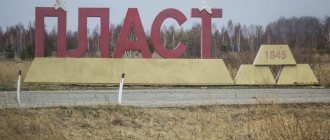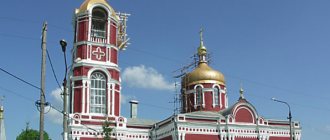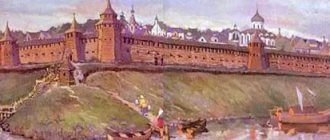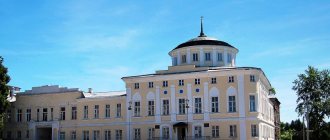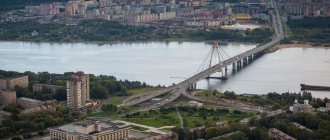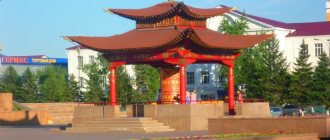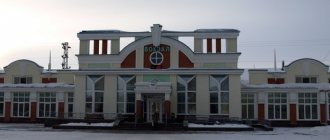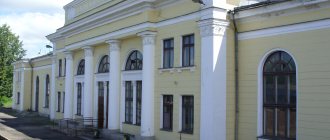This term has other meanings, see Rasskazovo (meanings).
| City Rasskazovo Flag | Coat of arms |
| A country | Russia, Russia |
| Subject of the federation | Tambov regionTambov region |
| Urban district | town of Rasskazovo |
| Coordinates | 52°40′00″ n. w. 41°53′00″ E. long / 52.66667° north w. 41.88333° E. d. / 52.66667; 41.88333 (G) [www.openstreetmap.org/?mlat=52.66667&mlon=41.88333&zoom=12 (O)] (Z)Coordinates: 52°40′00″ N. w. 41°53′00″ E. long / 52.66667° north w. 41.88333° E. d. / 52.66667; 41.88333 (G) [www.openstreetmap.org/?mlat=52.66667&mlon=41.88333&zoom=12 (O)] (I) |
| Chapter | Kolmakov Alexey Nikolaevich |
| Based | in 1697 |
| First mention | 1698 |
| City with | 1926 |
| Square | 36.12 km² |
| Center height | 150 |
| Population | ↘44,180[1] people (2016) |
| Density | 1223.15 people/km² |
| Names of residents | storyteller, storyteller |
| Timezone | UTC+3 |
| Telephone code | +7 47531 |
| Postcode | 393250 |
| Vehicle code | 68 |
| OKATO code | [classif.spb.ru/classificators/view/okt.php?st=A&kr=1&kod=68425 68 425] |
| Official site | [g31.tambov.gov.ru/ bov.gov.ru] |
| Rasskazovo Moscow |
| Tambov Rasskazovo |
K: Settlements founded in 1697
Raskazovo
- a city (since 1926[2]) in Russia, the center of the Rasskazovsky district of the Tambov region. Is a city of regional subordination; founded - as a rural settlement - in 1697[3].
Located in the central part of the Oka-Don (Tambov) plain, on the Lesnoy Tambov River (right tributary of the Tsna), at the confluence of the Arzhenka River: 10 km from the South-Eastern Railway Platonovka railway station, and approximately the same distance from the former Rasskazovo station (currently closed; now it is the Rasskazovo stopping point on the Rada - Platonovka section, 40 km east of Tambov).
City `s history
At the turn of the 17th-18th centuries, large villages arose on the territory of the present Rasskazovsky district: Rasskazovo, Verkhnespasskoye, Koptevo, Podosklyai, Nizhnespasskoye, Sayukino, Dmitrievshchina, Tatarshchino, in the 18th century - Nikolskoye, Rozhdestvenskoye, Khitrovo, Akhtyrka, Kobylinka (Kotovskoye), Znamenka, Osinovka, Novgorodovka (Betiny farm), Alekseevka, Lipovka, Kersha, in the 19th century - Picher, Platonovka, Ivanovka, Kamennye Ozerki, Teleshovka, Bogoslovka, Mozharovka, Nadezhdino.
Village Rasskazovo
known since 1697[4]; then the Morshan peasant Stepan Andreevich Rasskaz (Vodyanov) received a royal charter to found this settlement. The first inhabitants of the village were mainly peasants from the Tambov villages of Kulikovo and Morsha.
In the 18th - early 20th centuries, Rasskazovo was famous for its handicraft industries: knitting stockings, tanning leather, producing candles and soap. The sheepskin and fur trade was developed in the surrounding villages. By 1744, the Demidov distillery was operating. In 1754, factory production of cloth arose in Rasskazovo - at the factory of Tulinov and Olesov.
In 1774, near the village, tsarist troops defeated the rebel detachment of Ataman Ivan Kirpichnikov.
At the end of the 18th century, Emperor Paul I granted about three thousand village peasants to the Arkharov brothers - Ivan and Nikolai. The cloth factory of I.P. Arkharov in Rasskazov was then one of the largest in Russia. In the middle of the 19th century, there were cloth factories here: Arkharov, Ragozy (Arzhen factory), Malin and Poltoratsky factories (Bogoslovsky factories), 60 tanneries, two potash factories, a fair, a bazaar, and a postal station. There was an active grain trade, which noticeably weakened after the construction of the Tambovo-Kamyshinskaya railway line; At this time, the main items of trade were cattle, raw leather, and locally produced boots.
By the end of the 19th century, Rasskazovo was a large commercial and industrial center of the Tambov province (four cloth factories, a felt establishment, a distillery, as well as small tanneries, a soap factory, a steam mill and other enterprises). In total in 1913 there were about six thousand workers.
At the beginning of the 20th century there was also a postal and telegraph office, a telephone network, a zemstvo hospital, hospitals at the factories of the Aseev and Munda brothers, an emergency room at the Zheltov factory, a pharmacy, shelters for orphans and the elderly, Medvedev's electric theater, a network of zemstvo, parish and factory schools Since the 19th century, Rasskazovo has been a major center of Orthodox sectarianism: Christian Believers (Khlysty), Molokans, Subbotniks.
At the end of the 19th and beginning of the 20th centuries, Rasskazovo was one of the centers of musical life in the province (I. Kryuchenkov’s choir, the Aseev brothers’ theater).
Rasskazovo has had the status of a city since 1926.[5]
The modern city of Rasskazovo is an industrial satellite city of Tambov.
Rasskazovo
(Tambov Region)
OKATO code:
68425
Founded:
1698
City since:
1926 City of regional subordination
Center:
Rasskazovsky district
Telephone code (reference phone)
| 47531***** | 22-0-66 |
Deviation from Moscow time, hours:
0
Geographic latitude:
52°40′
Geographic longitude:
41°53′
Altitude above sea level, meters:
150 Sunrise and sunset times in the city of Rasskazovo
Industry
Throughout its history, Rasskazovo developed primarily as a center of agricultural production. The most famous agricultural enterprise is Gosplempttice.
In the 1990s. many enterprises in the city (especially those related to light industry: the production of woolen fabrics, leather production) either completely disappeared or sharply reduced production volumes[21].
Currently, the main enterprises include:
- Tannery
- Biochemical plant
- Spetsstroymashremont
- Metal structures plant "SVS-Tekhnika"
- Plempttice
- Rasskazovsky Electrotechnical Plant
There are knitting shops of private entrepreneurs and enterprises producing workwear from cloth. Currently, the Arzhensky Cloth Factory, the Rasskazovsky Knitwear factories, the Russian-Yugoslav joint venture Rasskazzovo-Invest (leather goods), Rameako (fur and fur coats) operate here; factories - heavy-duty vehicles "Altkam", "Remattra" (special vehicles, trailers), "Kozhevnik", biochemical, low-voltage equipment "Eltra"; dairy, beer, bakery and confectionery factories.[22]
Photo[edit]
- Church of St. John the Evangelist (Rasskazovo)
- Church of St. John the Evangelist (Rasskazovo)
- Church of St. John the Evangelist (Rasskazovo)
- Church of St. John the Evangelist (Rasskazovo)
- Church of St. John the Evangelist (Rasskazovo)
- Church of St. John the Evangelist (Rasskazovo)
- Church of St. John the Evangelist (Rasskazovo)
- Church of St. John the Evangelist (Rasskazovo)
- Church of St. John the Evangelist (Rasskazovo)
- Church of St. John the Evangelist (Rasskazovo)
- Church of St. John the Evangelist (Rasskazovo)
- Church of St. John the Evangelist (Rasskazovo)
- Church of St. John the Evangelist (Rasskazovo)
- Church of St. John the Evangelist (Rasskazovo)
- Church of St. John the Evangelist (Rasskazovo)
Monuments
- Church of St. John the Evangelist (1879)
- Church of St. Catherine, 1893 with factory hospital and shelter
- The palace and park ensemble of the former estate of the Aseev factory owners (1906). In 2011, reconstruction began.
- the remains of the estate of the noble Poltoratsky family, close friends of A. S. Pushkin[23] (most of the estate was demolished in 2014)
- park-estate of the Arkharov brothers (burnt down on October 10, 2015)
- the remains of factory architecture of the 18th-20th centuries: the cloth factories of Tulinov, Malin, Ragoza, Poltoratsky, Aseev, the Kryuchenkov distillery (the old factories have already been mostly dismantled for building materials and metal).
- merchant, trade, school, sectarian, administrative buildings of the 18th-20th centuries (recently they have been massively demolished and rebuilt)
4 km south of Rasskazovo there is an island section of the forest “Soulless Bush” (an area of over 100 hectares), on the territory of which part of the ancient Astrakhan salt tract has been preserved. According to legend cited by historians S.A. Bereznegovsky (1797-1868)[24] and I.I. Dubasov (1843-1913)[25], E.I. Pugachev’s troops were hiding in this forest.
Report “Attractions of the city of Rasskazovo” educational and methodological material on the topic
Sights of the city of Rasskazovo
Each of us has a corner dear to our hearts, a point on the geographical map where we were born, learned to speak, took our first steps in life - our small homeland. And it does not always turn out to be large cultural centers, industrial metropolises, but simple Russian villages, hamlets, small towns - ancient mansion houses adjacent to modern architectural forms... So identical and at the same time unique. My city Rasskazovo is also unique. It has not yet become a tourist center, although its attractions and unique corners are famous throughout the country. The city has preserved several outstanding architectural monuments of the 19th and early 20th centuries. One of these monuments is the Church of St. John the Evangelist (page 2). The first wooden church of St. John the Theologian was built in 1702 in the first years after the founding of the village and was the center of the dean's district. In the early 1820s. The rather dilapidated church was demolished. The new warm stone three-altar church in the name of the Holy Apostle John the Theologian was built only in 1879 (construction lasted 24 years) (page 3). The main altar was consecrated in honor of John the Theologian, the right one in honor of the Kazan Icon of the Mother of God, the left one in honor of Alexander Nevsky. The new church looked very elegant, its interior was elegantly decorated with stucco. The church had a three-tiered belfry with large ringing bells and a hipped dome. This church was built with public donations, the bulk of which came from the funds of the landowner K. Kryuchenkov and the factory brothers V.A. and T.A. Aseev. St. John the Theologian and Demetrius churches occupied the territory from the central to the station square and from Kuibyshevsky Proezd to 8th March Street. On the church grounds there was a parish cemetery with graves and crypts of the most respected residents and patrons of Rasskazovo. The persecution of the church began immediately after the revolution. At the end of 1923, the temple and church property were transferred to the renovation community. Believers tried unsuccessfully to challenge this decision. In 1929, the dome of the church collapsed and it was “temporarily” closed. In 1937 the church was finally closed. During these years, the old city cemetery near the temple was also destroyed. Most of the monuments were stolen, and the remains of people were taken away with construction waste. The crypts of honorary citizens were looted and burned. At the beheaded ancestral chapel-tomb of the Aseev industrialists and philanthropists, a water tank was installed for the needs of the fire department. The war prevented the temple from being completely destroyed. In 1943 it was returned to believers, repaired and opened for worship in 1945 (page 4). In 1947, Bishop Joasaph of Tambov and Michurinsky consecrated the former chapel of the Holy Blessed Prince Alexander Nevsky in honor of the saint and wonderworker Nicholas. The persecution of the church continued: the number and time of services were limited, it was forbidden to perform religious services, church sacraments, Epiphany bathing, religious processions, installing bells, etc. Vigils were organized in the church to prevent new believers from entering the church and to re-register existing ones. In the 1980s, persecution of the church gradually ceased. A fire station and a store are now built on the territory of the churchyard. Today the Church of St. John the Theologian is declared an architectural and historical monument. The church is being reconstructed and restored to its original form. In recent years, restoration of the Aseev chapel-tomb near the temple has begun (page 5).
An important landmark of the city is MBOU Secondary School No. 4, building 2. (layer 6). The school building was built at the beginning of the 20th century and belonged to the merchant Moiseev. From the autumn of 1918 to 1921, the People's House, a city club and library, operated there. The first pioneer detachment was organized here (page 7).
In 1921 - 1922, the building was occupied by CHON - part of a special purpose.
Since 1931, the building housed the Rasskazovsky Pedagogical School, which trained primary school and physical education teachers. The pedagogical school was the cultural center of the city.
Then the building housed boarding school No. 2 and an extension was made to the building.
On June 13, 1967, the boarding school was reorganized into a comprehensive secondary school with an extended day.
On September 1, 1967, secondary school No. 8 opened its doors to students.
From 2010 to the present, this is MBOU secondary school No. 4, building 2.
The main attraction of Rasskazovo is the palace and park ensemble of the former estate of the Aseev manufacturers. (sl. 9). A manor house built in 1902-1906 by order of Vasily Tikhonovich Aseev (page 10). A white stone building erected in eclectic stylistic forms and a huge estate complex consisting of a park, a pond, an industrial complex and other estate buildings. The luxurious estate of the Aseevs did not serve its owner for long. After the well-known events of the beginning of the last century, the estate complex went through some hard times. The palace and park were transferred to the management of an orphanage. This did not contribute in any way to the preservation of the estate, rather the opposite. In the “dashing” nineties, the mansion lost the remnants of its former luxury - it was plundered by vandals (page 11). According to the recollections of old-timers, literally everything was taken out of the house: from lighting fixtures to fragments of the marble staircase leading to the second floor. For a long time, only the remaining fragments of stucco molding reminded of the former grandeur of the mansion. The main manor house stood in ruins for about 20 years. It seemed that the historical monument could no longer be saved. However, in 2011, restoration work began on the estate, which is still ongoing. The white stone house has a rectangular shape in its layout (page 12.) The façade of the mansion is decorated with decorative elements of various styles, among which you can see modernist trends, features of classicism, and Gothic details (page 13.). The exterior decoration of the house is replete with stucco molding, decorative flowerpots and artistic forging. In pre-revolutionary years, the façade of the building was decorated with statues, which, unfortunately, have not survived to this day and were not recreated during the recent restoration (page 14). On the ground floor of the mansion there were vestibules (line 15), a staircase pavilion (line 16), Vasily Aseev's study (line 17), a living room (line 18), a fireplace room (line 19) and tea rooms (line 19). 20, 21). The second floor was occupied by: a columned hall (layers 22,23) and living rooms (layers 24,25,26). In addition, there is an opinion that on the second floor of the Rasskavsky mansion there was a small house church (page 27). Contemporaries recalled that the interiors of Aseev’s house amazed with their luxury (page 28). Other manor buildings were no less presentable. The horse yard, water tower and outbuildings also did not stand out from the general architectural concept of the estate complex (pages 29, 30). The grandeur and snow-whiteness of the house and the large park with fountains and greenhouses were emphasized (page 31). In addition to the linden and oak trees familiar to many estate parks, exotic plants grew in Rasskazovo. The Aseevs lived in the new house since 1903. After the revolution of 1917 and the nationalization of cloth factories, Vasily Aseev and his family were forced to leave Russia and settled in Austria in the city of Baden, where he died on April 22, 1941. He was buried in Vienna in the Russian part of the central cemetery.
An important landmark of the city is the family estate of the brothers Nikolai and Ivan Arkharov. (fn. 32) At the end of the 18th century, Paul I gave the village of Rasskazovo with lands and peasants as a reward for excellent service to the brothers, generals Arkharov: the governor-general of a number of provinces, chief police officer of Moscow Nikolai Petrovich (1740–1814) and the military governor of Moscow Ivan Petrovich (1784–1815) (page 33). Nikolai Petrovich was one of the famous people of his time. He became famous as an unusually talented detective who could solve any crime. Rumors circulated about Arkharov throughout Russia, and legends were formed. Nikolai Petrovich was held in high esteem by Paul I and Catherine II; the most famous in France, the first police favorite of Louis XV, admired his methods of work. Nikolai Petrovich successfully worked for the good of the Fatherland, then, in his old age, he left for his estate in Rasskazovo. The Arkharov estate was located on a high hill above the Danubechik River, where today the city garden is located. It was they who, at the beginning of the 19th century, organized a landscaped park, along which all subsequent generations walked until today. Nikolai Petrovich died in 1814. and was buried in the Tregulyaevsky Monastery. Since those times, a merchant mansion has been preserved on the territory, which was used for various purposes. In 2021, an accident occurred and the Arkharov estate burned down. All that remained were ruins and the memory of famous people (page 34).
In addition, the well-known estate of the Poltoratskys, friends of Alexander Sergeevich Pushkin (page 35). Alexander Markovich Poltoratsky - the former head of the cannon factory in Petrozavodsk, manager of the coin department - acquired an estate in Rasskazov in 1811. He came with 8 children, four of them were sons. A. Poltoratsky was well acquainted with A. Pushkin. Friendship with Pushkin ended suddenly after A. Poltoratsky’s military career ended. In 1821, Alexander Alexandrovich moved to his father’s estate in Rasskazovo - in fact, he lived in the position of a political exile. From 1837 to 1840 he was the leader of the Tambov nobility. In 1834, a happy event occurred in the life of the Rasskavsky exile: he married for the second time - the lady-in-waiting of the imperial court, Ekaterina Bakunina (1795 - 1869), the sister of Pushkin’s lyceum friend, the poet’s first youthful love, became his chosen one. They lived in the village of Bolshaya Bogoslovka, today it is Nekrasovskaya Street. Here, on a high bank near the Lesnaya Tambov River, there was a spacious two-story house. A village and a cloth factory with 438 peasants made up the estate of Alexander Poltaratsky. He quickly brought the abandoned cloth factory into exemplary condition. The Poltoratsky estate was confiscated immediately after the revolution. It housed a branch of the central library No. 2, a public education school and a House of Political Education. During the Second World War it was a hospital. And then it was given to the House of Culture of the Rasskazovskaya Cloth Factory. But when the cloth factory ceased to exist, the House of Culture also closed. Today, ancient buildings serve the townspeople. The library is located on the ground floor, occupies the former kitchen of the Poltoratskys. The building houses two police strongholds. On the second floor there is a sports section where the local rock band Atropin rehearses. The remains of the Poltoratsky estate are located in the Malshchina microdistrict of Rasskazov. This is how local historian Valentina Kuchenkova describes the appearance of this estate in the distant past. Quote from the book “Estates of the Tambov Region”: “The estate was located along the banks of the Lesnaya Tambov River. On one side of the river there was a house on a high basement, consisting of two outbuildings connected by a gallery and a balcony. The rooms in the gallery with vaulted ceilings were intended for household needs and yard service. From the balcony there was a view of the river backwaters and the forest summer residence of the Poltoratskys. The house was surrounded by a park, from which traces of a linden alley, jasmine and honeysuckle now remain. Dense thickets of lilac separated the estate from the peasant buildings....” (f. 36) And these are the impressions of the writer Emil Sokolsky from the modern appearance of the estate. He expressed his thoughts on the pages of the scientific and cultural magazine “RELGA”: “It takes about half an hour to get to Malshchina: behind the bridge over the fast Arzhenka, the road, leaving miniature merchant houses, leads to a “village” suburb with a cloth factory... Behind a public garden with rare linden and ash trees What meets you around the corner is a smooth-walled white house. (v. 37) It is difficult to recognize in this long, dry building, long ago adapted as a club, master’s chambers; but it is still better than strange brown buildings with figured cornices in the “factory” spirit.
In the city of Rasskazovo, the local history museum was first opened in 1974 (page 38). It was located in the city center in two small rooms of a parochial school. At the origins of its creation was the teacher Dmitry Petrovich Ignatov, an unusually enthusiastic person, dedicated to the development of local history for many decades. The largest part of the museum collection of that time reflected the history of the development of the textile industry in Rasskazov: at that time, one of the largest light industry enterprises in the country, the Arzhensky Cloth Factory, operated in the city, and the whole life of the Rasskazov workers in the past was connected, first of all, with the production of fabrics. In this regard, on October 11, 1977, the regional executive committee decided to create in the city the Museum of the History of Weaving and Textile Industry - a branch of the Tambov Regional Museum of Local Lore, the opening of which took place in a solemn ceremony on December 23, 1982. His presentation was attended by war and labor veterans, the best workers in the textile industry, honored cultural figures, and management of industrial enterprises of the city and region, which especially emphasized the importance of the event. Until 2005, the branch was headed by Alla Ivanovna Smolikova. In 2006, by the Decree of the Administration of the Tambov Region on the reorganization of regional state cultural institutions, the Museum of the History of Weaving and Textile Industry in Rasskazovo, as a branch of TOKM, was liquidated. Based on his funds, the Municipal Budgetary Institution “Museum of Local Lore of the city of Rasskazovo, Tambov Region” was created. Thus began a new milestone in the development of the institution. Having acquired the status of an independent legal entity, the museum continues to work fruitfully for the benefit of the city. Currently, the institution has 11 permanent exhibitions, including historical and local history (sl. 39,40,41,42), art history (sl. 43,44,45), natural history (sl. 46), military-patriotic (sl. sl47,48). Temporary exhibitions are organized in the exhibition hall: art, arts and crafts, private collections are displayed and much more. The institution carries out broad, diverse work to promote the history and culture of its native land, civil-patriotic and spiritual-moral education of the younger generation, provides excursion and lecture services for visitors, carries out cultural work among the population, organizing presentations of exhibitions, meetings, lessons of courage, master classes, etc. In order to awaken interest in the historical and cultural values of our small homeland, the museum, along with traditional ones, is introducing innovative forms of work with the younger generation, taking into account the age characteristics of children. The institution’s staff takes an active part in many events on a city and regional scale, participates in the annual cultural and educational events “Night of Museums” and “Night of the Arts”, within the framework of which it prepares a special program for visitors of all ages. During its existence, the museum has taken a worthy place in the cultural life of the city.
The sights of our city are amazing and very beautiful places that should be protected and restored, otherwise they will only be memories, but this is the cultural heritage of our ancestors.
Famous people
- Sergeev-Tsensky, Sergei Nikolaevich - writer
- Markov, Moisei Aleksandrovich - physicist, academician of the Russian Academy of Sciences
- Cherkasov Evgeny Aleksandrovich - lieutenant, commander of battery No. 19 BM-13 (Katyusha) in the 19th Army of the Western Front [26]
- Lenkov Alexander Sergeevich is a Soviet and Russian theater and film actor. People's Artist of Russia (1997)
- Komyagin, Alexander Valerievich - Hero of the Russian Federation
- Ovchinnikov, Vyacheslav Viktorovich - Russian military leader, Colonel General, Doctor of Law
- Popov, Boris Petrovich - Hero of the Soviet Union
- Guseva Klara Ivanovna is an Olympic champion in speed skating, born[27] in the village of Picher (the source erroneously says “Pichersk”), Rasskazovsky district.
An excerpt characterizing Rasskazovo
Of all the hounds, 54 dogs were bred, under which 6 people went out as handlers and catchers. In addition to the masters, there were 8 greyhound hunters, who were followed by more than 40 greyhounds, so that with the master's packs about 130 dogs and 20 horse hunters went out into the field. Each dog knew its owner and name. Each hunter knew his business, place and purpose. As soon as they left the fence, everyone, without noise or conversation, stretched out evenly and calmly along the road and field leading to the Otradnensky forest. The horses walked across the field as if walking on a fur carpet, occasionally splashing through puddles as they crossed the roads. The foggy sky continued to descend imperceptibly and evenly to the ground; the air was quiet, warm, soundless. Occasionally one could hear the whistling of a hunter, the snoring of a horse, the blow of an arapnik, or the yelp of a dog that was not moving in its place. Having ridden about a mile away, five more horsemen with dogs appeared from the fog to meet the Rostov hunt. A fresh, handsome old man with a large gray mustache rode ahead. “Hello, uncle,” Nikolai said when the old man drove up to him. “It’s a real march!... I knew it,” said the uncle (he was a distant relative, a poor neighbor of the Rostovs), “I knew that you couldn’t stand it, and it’s good that you’re going.” Pure march! (This was my uncle’s favorite saying.) - Take the order now, otherwise my Girchik reported that the Ilagins are standing in Korniki with pleasure; You have them - pure march! - they will take the brood under your nose. - That's where I'm going. What, to bring down the flocks? - Nikolai asked, - get out... The hounds were united into one pack, and uncle and Nikolai rode side by side. Natasha, wrapped in scarves, from under which a lively face with sparkling eyes could be seen, galloped up to them, accompanied by Petya and Mikhaila, the hunter who was not far behind her, and the guard who was assigned as her nanny. Petya laughed at something and beat and pulled his horse. Natasha deftly and confidently sat on her black Arab and with a faithful hand, without effort, reined him in. Uncle looked disapprovingly at Petya and Natasha. He did not like to combine self-indulgence with the serious business of hunting. - Hello, uncle, we're on our way! – Petya shouted. “Hello, hello, but don’t run over the dogs,” the uncle said sternly. - Nikolenka, what a lovely dog, Trunila! “he recognized me,” Natasha said about her favorite hound dog. “Trunila, first of all, is not a dog, but a survivor,” thought Nikolai and looked sternly at his sister, trying to make her feel the distance that should have separated them at that moment. Natasha understood this. “Don’t think, uncle, that we will interfere with anyone,” said Natasha. We will remain in our place and not move. “And a good thing, countess,” said the uncle. “Just don’t fall off your horse,” he added: “otherwise it’s pure marching!” – there’s nothing to hold on to. The island of the Otradnensky order was visible about a hundred yards away, and those arriving were approaching it. Rostov, having finally decided with his uncle where to throw the hounds from and showing Natasha a place where she could stand and where nothing could run, set off for a race over the ravine. “Well, nephew, you’re becoming like a seasoned man,” said the uncle: don’t bother ironing (etching). “As necessary,” answered Rostov. - Karai, fuit! - he shouted, responding with this call to his uncle’s words. Karai was an old and ugly, brown-haired male, famous for the fact that he single-handedly took on a seasoned wolf. Everyone took their places. The old count, knowing his son’s hunting ardor, hurried not to be late, and before those who arrived had time to drive up to the place, Ilya Andreich, cheerful, rosy, with trembling cheeks, rode up on his little black ones along the greenery to the hole left for him and, straightening his fur coat and putting on his hunting clothes, shells, climbed onto his smooth, well-fed, quiet and kind, gray-haired Bethlyanka like him. The horses and droshky were sent away. Count Ilya Andreich, although not a hunter by heart, but who firmly knew the hunting laws, rode into the edge of the bushes from which he was standing, took apart the reins, adjusted himself in the saddle and, feeling ready, looked back smiling. Next to him stood his valet, an ancient but overweight rider, Semyon Chekmar. Chekmar kept in his pack three dashing, but also fat, like the owner and the horse - wolfhounds. Two dogs, smart, old, lay down without packs. About a hundred paces further away in the edge of the forest stood another of the Count's stirrups, Mitka, a desperate rider and passionate hunter. The Count, according to his old habit, drank a silver glass of hunting casserole before the hunt, had a snack and washed it down with a half-bottle of his favorite Bordeaux. Ilya Andreich was a little flushed from the wine and the ride; his eyes, covered with moisture, shone especially, and he, wrapped in a fur coat, sitting on the saddle, had the appearance of a child who was going for a walk. Thin, with drawn-in cheeks, Chekmar, having settled down with his affairs, glanced at the master with whom he lived for 30 years in perfect harmony, and, understanding his pleasant mood, waited for a pleasant conversation. Another third person approached cautiously (apparently he had already learned) from behind the forest and stopped behind the count. The face was that of an old man with a gray beard, wearing a woman's hood and a high cap. It was the jester Nastasya Ivanovna. “Well, Nastasya Ivanovna,” the count said in a whisper, winking at him, “just trample the beast, Danilo will give you the task.” “I myself... have a mustache,” said Nastasya Ivanovna. - Shhh! – the count hissed and turned to Semyon. – Have you seen Natalya Ilyinichna? – he asked Semyon. - Where is she? “He and Pyotr Ilyich got up in the weeds from the Zharovs,” answered Semyon, smiling. - They are also ladies, but they have a great desire. - Are you surprised, Semyon, how she drives... huh? - said the count, if only the man was in time! - How not to be surprised? Boldly, deftly. -Where is Nikolasha? Is it above the Lyadovsky top? – the count kept asking in a whisper. - That's right, sir. They already know where to stand. They know how to drive so subtly that sometimes Danila and I are amazed,” said Semyon, knowing how to please the master. - It drives well, huh? And what about the horse, huh? - Paint a picture! Just the other day, a fox was snatched from the Zavarzinsky weeds. They began to jump over, out of delight, passion - the horse is a thousand rubles, but the rider has no price. Look for such a fine fellow! “Search...,” the count repeated, apparently regretting that Semyon’s speech ended so soon. - Search? - he said, turning away the flaps of his fur coat and taking out a snuff box. “The other day, as Mikhail Sidorich came out from mass in full regalia...” Semyon did not finish, hearing the rut clearly heard in the quiet air with the howling of no more than two or three hounds. He bowed his head, listened and silently threatened the master. “They’ve attacked the brood...” he whispered, and they led him straight to Lyadovskaya. The count, having forgotten to wipe the smile from his face, looked ahead along the lintel into the distance and, without sniffing, held the snuffbox in his hand. Following the barking of the dogs, a voice was heard from the wolf, sent into Danila’s bass horn; the pack joined the first three dogs and the voices of the hounds could be heard roaring loudly, with that special howl that served as a sign of the rutting of the wolf. Those arriving no longer squawked, but hooted, and from behind all the voices came Danila’s voice, sometimes bassy, sometimes piercingly thin. Danila’s voice seemed to fill the entire forest, came out from behind the forest and sounded far into the field. After listening in silence for a few seconds, the count and his stirrup became convinced that the hounds had split into two flocks: one large one, roaring especially hotly, began to move away, the other part of the flock rushed along the forest past the count, and in the presence of this flock Danila’s hooting could be heard. Both of these ruts merged, shimmered, but both moved away. Semyon sighed and bent down to straighten the bundle in which the young male was entangled; The count also sighed and, noticing the snuff-box in his hand, opened it and took out a pinch. "Back!" Semyon shouted at the dog, who stepped out beyond the edge. The Count shuddered and dropped his snuffbox. Nastasya Ivanovna got down and began to lift her. The Count and Semyon looked at him. Suddenly, as often happens, the sound of the rut instantly came closer, as if, right there in front of them, there were the barking mouths of dogs and the hooting of Danila. The count looked around and to the right he saw Mitka, who was looking at the count with rolling eyes and, raising his hat, pointed him forward, to the other side. - Take care! - he shouted in such a voice that it was clear that this word had been painfully asking him to come out for a long time. And he galloped, releasing the dogs, towards the count. The Count and Semyon jumped out of the edge of the forest and to their left they saw a wolf, which, softly waddling, quietly jumped up to their left to the very edge at which they were standing. The evil dogs squealed and, breaking away from the pack, rushed towards the wolf past the legs of the horses. The wolf stopped running, awkwardly, like a sick toad, turned his big forehead to the dogs, and also softly waddling, jumped once, twice and, shaking a log (tail), disappeared into the edge of the forest. At that same moment, from the opposite edge of the forest, with a roar similar to crying, one, another, a third hound jumped out in confusion, and the whole pack rushed across the field, through the very place where the wolf had crawled (ran) through. Following the hounds, the hazel bushes parted and Danila’s brown horse, blackened with sweat, appeared. On her long back, in a lump, lolling forward, sat Danila, without a hat, with gray, tousled hair over a red, sweaty face. “Whoop, whoop!” he shouted. When he saw the count, lightning flashed in his eyes. “F...” he shouted, threatening the count with his raised arapnik. -About...the wolf!...hunters! - And as if not deigning the embarrassed, frightened count with further conversation, he, with all the anger he had prepared for the count, hit the sunken wet sides of the brown gelding and rushed after the hounds. The Count, as if punished, stood looking around and trying with a smile to make Semyon regret his situation. But Semyon was no longer there: he, taking a detour through the bushes, jumped the wolf from the abatis. Greyhounds also jumped over the beast from both sides. But the wolf walked through the bushes and not a single hunter intercepted him. Nikolai Rostov, meanwhile, stood in his place, waiting for the beast. By the approach and distance of the rut, by the sounds of the voices of dogs known to him, by the approach, distance and elevation of the voices of those arriving, he felt what was happening on the island. He knew that there were arrived (young) and seasoned (old) wolves on the island; he knew that the hounds had split into two packs, that they were poisoning somewhere, and that something untoward had happened. Every second he waited for the beast to come to his side. He made thousands of different assumptions about how and from which side the animal would run and how it would poison it. Hope gave way to despair. Several times he turned to God with a prayer for the wolf to come out to him; he prayed with that passionate and conscientious feeling with which people pray in moments of great excitement, depending on an insignificant reason. “Well, what does it cost you,” he said to God, “to do this for me! I know that You are great, and that it is a sin to ask You for this; but for the sake of God, make sure that the seasoned one comes out on me, and that Karai, in front of the “uncle” who is looking over there, slams into his throat with a death grip.” A thousand times during these half-hours, with a persistent, intense and restless gaze, Rostov looked around the edge of the forests with two sparse oak trees over an aspen undergrowth, and the ravine with a worn edge, and the uncle’s hat, barely visible from behind a bush to the right.

